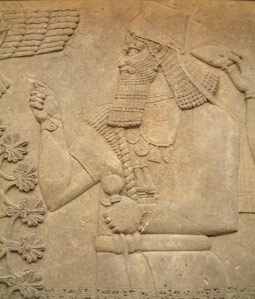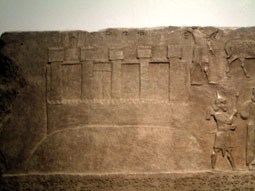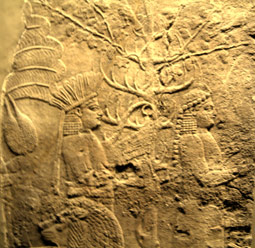Celestial & terrestrial divination
The gods, it seems, were continually sending messages of approval or disapproval to the Assyrian king. Fully half the surviving corpus of royal scholarly correspondence concerns ominous events observed in the sky or on the earth. Astrologers TT stationed in a dozen different Assyrian and Babylonian cities simultaneously "kept the watch of the king". How did they record and analyse this steady flow of data? And how did the king select and construct meaning from this often contradictory stream of information, in order to make effective political decisions that had divine support?
Signs from the sky

The celestial omen series Enuma Anu Enlil was divided into four large sections, governed by the moongod Sin (lunar events), the sungod Šamaš (solar events), the weathergod Adad (atmospheric phenomena), and Ištar/Venus (movements of the five visible planets). Here the Assyrian king wears a protective necklace showing the symbols of Sin, Šamaš, Aššur or Adad (?), and Ištar. Detail from the stone decoration of Assurnasirpal II's northwest palace in Nimrud, c.860 BC (room B, panel 23; BM ANE 124531). Photo by Eleanor Robson. View large image.
As the moon and planets TT traverse the night sky against the slower-moving background of the stars, they appear to cluster and disperse in an intricate dance of approach and retreat. In the city of Babylon PGP , a systematic celestial TT observation programme had begun in the mid-8th century BC that would eventually decode the complex patterns of long-term periodicities that underlie these apparently random conjunctions TT , retrogrades TT , and oppositions TT . But for the scholars of the seventh-century Assyrian royal court it was not yet possible to make confident predictions of anything but imminent celestial events. The gods, it appeared, inscribed their intentions for the world on the night sky by directing the nocturnal movements of the heavenly bodies towards particular timings and configurations that could be read and interpreted just like cuneiform writing or the entrails of a sacrificed ram. Just as the planets were in some senses "counterparts" to the great gods, so the night sky presented an oblique view of the gods' Tablet of Destinies, made of sparkling, deep blue lapis lazuli TT , on which they planned the fate of the world.
The Assyrian scholars have left no clues as to how they made their observations, except that beyond the royal court in Nineveh PGP they worked in groups of ten. Some ominous events took place on the horizon TT at dusk or dawn - namely the first and last appearances TT of the moon, planets, and reference constellations in their periodic cycles of visibility. Other events, such as eclipses TT or planetary conjunctions, could occur at any time of night and anywhere near the ecliptic, the path of the sun. In good weather, all were visible with the naked eye. However, like extispicy TT and cuneiform literacy, celestial signs were not transparently decodable by a casual observer. Which events in the sky counted as ominous, and what they each portended, was recorded in the great canonical TT series Enuma Anu Enlil. It comprised many thousands of omens over some 70 standardised tablets TT , grouped according to the time and disposition of the phenomenon observed. For instance, Tablets 59-60 concerns the behaviour of Venus PGP throughout the year. The entries for Ab (Month V) TT read in their entirety:
If Venus rises in Ab: there will be rains, there will be famine and destruction.
If Venus in Ab constantly has a white flare (?): there will be famine in the land; or the king will become strong and the land [...].
If Venus in Ab descends darkly to the horizon; or remains dimmed: the downfall of Elam PGP and its army will occur in that month; or will occur through weapons.
If Venus in Ab rises and a meteor TT lies crosswise in front of her: there will be a famine; or the king will become powerful [...].
If Venus is dark in Ab: the king will become powerful and the land will be happy.
While the Assyrian royal haruspices TT used a tiny fraction of their canonical omen series and the exorcists TT virtually ignored theirs, the astrologers made such heavy use of Enuma Anu Enlil that they exhausted its repertoire and had to generate new omens on the same model. Compare, for instance, the reports of Balasi PGP , Nabu-mušeṣi PGP , and Nergal-eṭir PGP on Venus's disappearance in Ab (SAA 8: 96, 156, 246). Two quote the omen predicting the fall of Elam but all three also cite one that is not found in Enuma Anu Enlil:
If Venus disappears in the west in Ab (at any time) from the 1st to the 30th day: there will be rains; the harvest of the land will prosper.
This non-canonical omen is clearly constructed on the same principles as its canonical counterparts. It describes a similar type of event to the first appearance of Venus in Ab, so it too portends rain. But it is also the opposite type of event, so instead of famine and destruction it foretells a prosperous harvest. Thus gaps in the canonical omen series could be filled seamlessly by extrapolating and interpolating from event-outcome relationships using the same logic as Enuma Anu Enlil.
Signs from the earth

"If a city is set on a height: its inhabitants will be depressed." So runs the first line of the terrestrial omen series Šumma alu. The hill city of Astartu in Jordan, as depicted on the stone decoration of Tiglath-pileser III's palace in Nimrud, c.730 BC. BM ANE 11908 (detail). Photo by Eleanor Robson. View large image.
The gods also sent messages in the form of strange birth events and other terrestrial TT happenings, whose meanings were catalogued in the canonical omen series Šumma izbu TT and Šumma alu TT . The watch for these was much less systematic, although Assyrian citizens were expected to report any potentially ominous occurrences to the palace (e.g., SAA 8: 287). The royal scholars generally took a much more relaxed view of terrestrial omens than Esarhaddon did. In surviving letters he quizzes the chief scribe Issar-šumu-ereš PGP about the ominous import of a mongoose TT under his chariot, asks the senior astrologer Balasi for omens about ravens TT bringing objects into a house (the palace?), and contests his reading of Šumma izbu (SAA 10: 33, 58, 60). Esarhaddon clearly wore Balasi's patience thin, for in early 670 BC he sent this reprimand (SAA 10: 42):
As to what the king, m[y lord, wr]ote [to me]: "[In] the city of H[ar]ihumba PGP lightning struck and ravaged the fields of the Assyrians" - why does the king look for (trouble), and why does he look (for it) [in the ho]me of a tiller? There is no evil inside the palace, and when has the king ever visited Harihumba?
Nevertheless, to keep Esarhaddon happy he goes on to recommend an exorcistic ritual for the palace, despite stating firmly that the relevant omen "applies (only) to the one who was cultivating the field".
Royal decision-making

We have little sense of the ritual setting of celestial divination, but given its high courtly status and its intellectual parallels with extispicy the rites and ceremonies surrounding it are likely to have been substantial and elaborate. Here two ritual performers attend a royal lion hunt. Detail of the stone decoration of Assurbanipal's north palace in Nineveh (room E, panel 5; BM ANE 118916). Photo by Eleanor Robson.
Fewer than ten terrestrial omen reports survive, compared to more than 550 astrological reports (SAA 8). Most of the latter, unsurprisingly, are from astrologers but many were written by exorcists and other scholars. Some 200-odd routinely announce a new or a full moon at the beginning or the middle of the month, and quote the relevant omens indicating business as usual (e.g., SAA 8: 10, 15). Many more, however, required further analysis and discussion - especially as different astrologers observing the same event might view its ominous import differently. For instance, when Mars PGP first became visible on the horizon at sunset in the summer of 670 BC, three astrologers informed the king (SAA 8: 114, 143, 341). For Bulluṭu PGP what mattered was the proximity of Jupiter PGP ; for Nabu-mušeṣi it was the month of Tammuz TT that counted; and for Ašaridu the Younger PGP it was most significant that it had happened in the constellation Gemini PGP . The omens they selected as pertinent reflected these different interpretative choices and were thus significantly different from one another.
How, then, was the king to choose who to believe when the scholars couldn't agree? And how was he to make political decisions on the basis of such conflicting data? It might seem that ominous prediction was such a hopeless mess that the king would have been better off without it. So why did the system persist, with such prestige and power, over so many centuries? Were the Assyrian elite all gullible fools - or were they simply keeping up appearances for the sake of tradition? The anthropological study of omens across a variety of world cultures suggests not.
Most divinatory systems, from I-Ching to newspaper horoscopes, serve similar sorts of psychological functions. The client usually consults them with a particular question in mind, or in the context of a problem that needs to be resolved. The omens generated by the system (whatever it may be) tend to be allusive and suggestive rather than definite and specific. In reading and pondering the omens with a particular situation in mind, the client gradually distinguishes those that are particularly meaningful or relevant. In other words, a divinatory message only becomes ominous if it resonates with the client's thoughts and feelings; the rest are discarded as background noise. Omens can thus be a tool for thinking with, enabling the client to focus on a problem, perhaps confirming a course of action already considered or, by randomly generating alternative scenarios, freeing him to consider the matter afresh. If the omens fail to provide an answer the first time round, they can be taken again.
In the Assyrian king's case, there were also questions of status at play. As supreme ruler of the region's greatest empire, he could not be seen to be weak or vacillating. Ominous messages from the gods allowed him and his advisors to ponder weighty matters of state together without the king being seen to lose standing by consulting lesser men than him. His decisions were given divine authority, making it difficult for his courtiers to dissent. The divinatory systems of celestial omens and extispicy, on which Esarhaddon and Assurbanipal particularly depended, were further reinforced by their social status as the preserves of highly educated, literate elite practitioners, which relied on considerable investment of time, resources, and effort. While divination no longer has the public prestige that it did in Assyrian times, in recent history such powerful men as Ronald Reagan and François Mitterand have had recourse to astrologers, while some major world leaders still claim divine assent for war. We are perhaps not so far from the Assyrian mindset as we might like to think.
Further reading
- Freedman, If a city, 1998
- Guinan, 'Social constructions', 1996
- Hunger, Astrological reports, 1992, Introduction
- Koch-Westenholz, Mesopotamian astrology, 1995
- Leichty, Omen series šumma izbu, 1969
- Park, 'Divination', 1963
- Rochberg, The heavenly writing, 2004
Content last modified: 05 Dec 2016.
Eleanor Robson
Eleanor Robson, 'Celestial & terrestrial divination', Knowledge and Power, Higher Education Academy, 2016 [http://oracc.museum.upenn.edu/saao/knpp/essentials/celestialterrestrialdivination/]